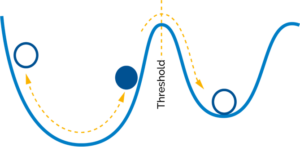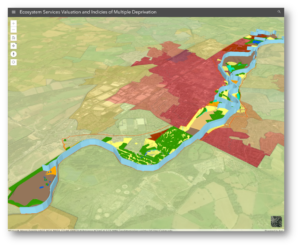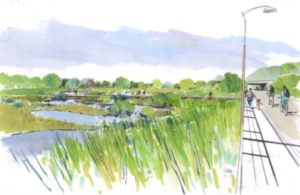SuDS, natural capital and economic resilience: what does systems thinking tell us?
Fran Moore, Principal Environmental Economist at Black & Veatch
Urban systems are constantly adapting to change. They are not static; they need to ‘stretch and breathe’ (have resilience) – so that they can deal with unexpected events. SuDS promote resilience as they give natural processes a chance to do this.
In a recent webinar, I explore how systems thinking and natural capital approaches can promote economic resilience against challenges such as biodiversity loss, flood risk and water pollution. So how can this promote SuDS?
The economy is deeply embedded within social and natural systems
The economy is a sub-system of the natural world. It is completely dependent on the integrity of the natural world to function and exist.
The natural world is primarily seen as a side line to the economy (Fig. 1 left) rather than encompassing it (Fig. 1 right).

Figure 1 views of the economy in relation to the natural world
There has been a recent subtle change from paying no heed to our dependence on natural systems, to mitigation of environmental impact, to potentially mandatory net gain – as included in the Environment Bill.
The shift needs to go further – to recognise urban infrastructure as dependent on natural processes and to see it as an opportunity to invest in nature for future gain.
SuDS can restore ‘critical feedbacks’ in systems to promote resilience

An often-used analogy for resilience is to imagine a ball rolling around in a cup. The bottom of the cup is its stable state. If knocked too hard, the ball falls out of the cup into another system. The cup has feedbacks in place to get the ball back to its stable state. Remove the feedbacks and the ball passes into a different system. All systems have these feedbacks in place to deal with something affecting them, so why worry?
Our resource decisions have been slowly knocking out these feedback mechanisms. It is in our interest to make the cup as broad and deep as possible, so that there is plenty of space for the ball to move around, to stretch and breathe.
Resilience is about which feedbacks are critical to each system. We can then target interventions and investment toward these critical feedbacks in degraded systems.
Using natural capital approaches to direct investment to SuDS.
Natural capital approaches show the link between nature and human well-being; they are seen as a ‘flow’ of benefit, from natural stock (land, water, air etc.) which generates goods often with input of other capital (intellectual, man-made), to which we attach a value.
Restoring natural processes helps to avoid future unknown costs (as well as existing costs), to build a buffer to future crises, and improve the well-being of future generations.
The pathway – stocks, flows, value – is increasingly seen as a means to source investment. This is a seismic shift from traditional funding sources– $31tn is currently held in green investments, up 35% from 2016.
There is a pressing need for investment-ready, SuDS portfolios (see for example DC Water, USA). People are waiting to buy into nature’s restoration – especially where aimed at urban resilience.


B&V has been working for the Environment Agency and partners since 2018 to transform 630-hectares of functional floodplain in Burton upon Trent.
Works include restoring the river to a more natural channel, creating wetlands and woodland, scrapes and pools, with boardwalks through this mosaic of habitats.
Our natural capital valuation quantified the additional economic benefit of this nature restoration at £2.66m PVb (40yrs), which attracted £2.5m investment specifically for the environmental enhancements.
CIRIA’s Benefits Evaluation Tool (B£ST) is also used for monetary valuation of the benefits of blue-green infrastructure; results – also in terms of Natural and other capitals – enable users to understand and quantify the wider value of SuDS and natural flood management measures which can support investment decisions and help find potential funding.
So what does systems thinking tell us?
Systems thinking can help target SuDS to restore ‘critical feedbacks’. Illustrating the restorative properties of multiple SuDS within an urban ‘resilience’ portfolio is a means to attract investment in them.
To create resilient urban systems that can ‘stretch and breathe’, we can choose the sub-system we’re interested in, eg health, water, education and focus on building resilience there. Resilience can then ripple out through adjoining and over-arching systems to build urban resilience over all.